The overall quality of a professional translation is based on a number of criteria: the translator’s experience, mastery of both languages, knowledge of the specific domain, their style and tone, and on the terms they employ. However, from one client to another, specific terminology is susceptible to change. Term management is often overlooked, but this preparatory step between the client and translator is essential to guarantee a quality translation that responds to the client’s expectations.
How do you manage a term base? What exactly is a term base? Who is responsible for it, the client or the linguistic service provider? Read this article to learn all this and more!
What is a term base?
In the world of professional translations, term management takes one of two forms:
- The creation of specific themed (e.g.: finance, chemistry, jewellery, health, etc.) or client-based glossaries;
- The implementation of translation memories.
When creating glossaries, usually via a bi- or multi-lingual Excel document, a linguist collects terms over the course of multiple projects or just before starting a translation. The idea is to gather the technical terms contained in the documents, including recurrent terms and those specific to the client, in order to propose a pertinent option that will be validated by the client.

Implementing a translation memory requires specific tools: Computer-Assisted Translation (CAT) software. At TradOnline, we primarily use memoQ. CAT tools allow entire translations to be cut into sentence long segments and saved. This allows us to easily find certain terms or similar syntactical structures that can be reused in future translations. This tool also allows us to create term bases that can be added to each project to ensure that the translator uses the correct terminology. If you’d like to learn more about translation memories, take a look at one of our previous blogs here.
Why is a term base so important?
Translation projects may occur regularly or very sporadically, for example catalogs published biannually. They may be handled by a single translator or different ones (translations handled internally by the client or even using a different service provider). It therefore becomes necessary for maintaining coherence over different projects and over the course of time in order to make sure the validated terminology is employed.
At TradOnline, we make it a point of honour to use and verify our clients’ preferred terminology. That’s why we insist on systematic management of term bases across all our clients, regardless of the size or technicity of the project. A good term base helps:
- Translators produce more coherent and better quality translations that respond to clients’ expectations, especially where terminology is concerned;
- Reduce the time for translation and revision, thus reducing costs;
- Improve communication within businesses, between their staff, partners, and other stakeholders.
The importance of term management by a professional
Studies have shown that experienced translators consecrate 20-25% of their time to terminological research, whereas newer translators spend 40-60% of their time in the same pursuit.
That’s why terminological research should be handled by an expert, because only an expert will know which term banks are reliable and will be able to propose an appropriate translation. Therefore, we recommend that as a translator translates, they also save pertinent term data. Given that this activity requires a considerable amount of time and effort, it is only logical to think ahead to inevitable future projects and prevent the need for repeat searches.
On top of these term bases created by linguists, it is imperative that each client communicates their particular preferences when it comes to terminology, just as they should when it comes to a particular proposed translation. Thus, once a document has been established and confirmed, it can be used as a reference, not only for the translator, but for any members of staff who work in copywriting, communications, advertising… anyone who works with official documents. This will allow everyone involved in the process of creating these texts to have a referential document they can use when choosing which terms to employ. This helps harmonize terminology across multiple actors and helps facilitate and ameliorate the proofreading and quality assurance globally.
We’re here to make your translation process as successful and pleasant as possible. Get in contact with us if you’d like more information or want to start working on developing a term base. Our team of professionals will be happy to assist you in the process of implementing a term base and choosing the appropriate terms and solutions to ensure harmony between your various documents.
[1] Guy Champagne, cité par Lynne Bowker, « Terminology and Translation » in Hendrik J. Kockaert, Frieda Steurs, éd., Handbook of Terminology: Volume 1, John Benjamins Publishing Company, 2015, p. 311.

